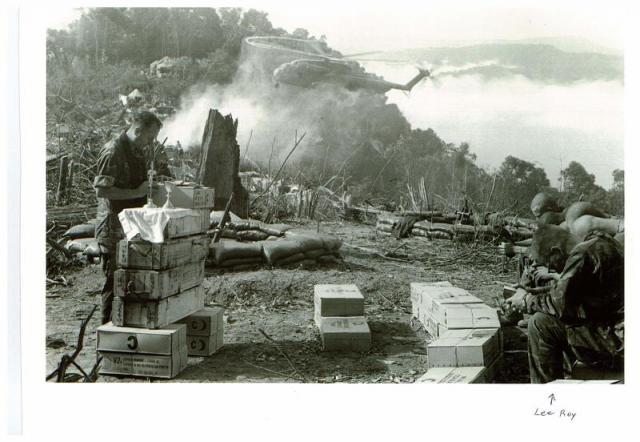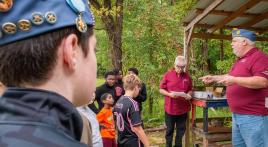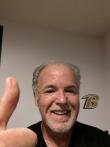50 years ago in the Summer of 1966, Lee Roy Herron and I traveled from Lubbock, Texas, to Quantico, Virginia, to attend Marine Corps Officer Candidates School. To no one’s surprise who knew him, Lee Roy finished his training as Company Honor man. As for me, I felt proud and lucky just to graduate at the end of a ten week course.
Lee Roy and I were commissioned as Marine 2nd Lieutenants on June 7, 1967, after graduation from Texas Tech University. A few months later Lee Roy went on active duty and I began law school at SMU since I was in a Marine Corps law program. Eventually, Lee Roy was stationed in Vietnam and was killed in battle on February 22, 1969.
For years after his death, I knew almost nothing of the circumstances of Lee Roy’s death, and had no idea he had died heroically. But eventually I saw a copy of the photograph that had been published in the March 5, 1969 edition of the Navy Times. I also met Lee Roy’s Company Commander in Vietnam, now retired Marine Colonel, Wes Fox. Fox had been a 1st Lieutenant in Vietnam and as I discovered, had written a posthumous Navy Cross citation for Lee Roy. For his actions in the same battle in which Lee Roy had been killed, Fox had been awarded the Medal of Honor.
Through further research into the background of the photograph, I managed to locate the Chaplain shown in the photo, now retired Navy Captain Salvatore Rubino. Chaplain Rubino eloquently described the circumstances of the photograph in a letter to me, and Colonel Fox provided details about Lee Roy’s actions in Vietnam, particularly as related to Lee Roy’s strong spirituality and heroism.
Here are some excerpts from Chaplain Rubino’s letter to me:
“I arrived in the Republic of Vietnam for duty with the Third Marine Division on 8 September 1968. Upon my arrival, I was assigned to the Second Battalion of the 12th Marine Regiment, an artillery unit in direct support of the 9th Marine Regiment.”
“To refresh my mind about the picture taken by PFC C. E. Sickler, Jr., at Fire Support Base Razor on 26 January, 1969, I decided to look back at some letters I wrote to my wife during that period.”
“We landed at Fire Base Razor yesterday at 1600. This fire base is high on a mountain at approximately 2000 feet and is located in the Ashau Valley. This fire base, as all the others, was created by an initial bombing from the air, followed by tractors (which were flown in by helicopter) which smoothed the mountain top to accommodate our 105mm artillery pieces, mortars, ammunition, C-rations, water and personnel.”
“This morning I conducted religious services at Fire Base Razor and offered communion to the 9th Regiment Headquarters. A photographer was there to take a picture during the service.”
“Mr. Nelson, although I do not recall your friend Lee Roy, I must express my deepest admiration for this young man who may have been worshipping with me and other Marines at that fire base. The picture itself speaks thousands of words. There was the utter desolation and destruction all around. There was the noise. Often, even during worship services, fire power was called in and the guns would roar. We were tired, and some were more exhausted than others. I recall that just before I served communion, a helicopter approached to deliver ammunition. The wind generated by the rotor was so strong that I had to cover the chalice with my hands to keep it from flying away. I was even afraid that the altar, made up of five C-ration boxes and four ammo-boxes, would bite the dust.”
“That day, the men seated on those C-ration boxes with their heads bowed, transformed that place into hallowed ground—a cathedral in the middle of nowhere. As the men received communion I saw tears touching their cheeks as they worshipped God. One Marine—whose glasses, I vividly remember, had dropped to the dusty ground because of the helicopter—came to me at the end of the service, shook my hand and said from the bottom of his heart, ‘Thank you, Chaplain, for bringing God to such an ungodly place.”
Chaplain Rubino would not have remembered Lee Roy by name since the day of the photograph, January 26, 1969, was the only time Lee Roy attended religious services at Fire Support Base Razor. He had traveled by helicopter over ten miles of enemy territory just to attend services that day, returning after the service to his assigned base, Fire Support Base Shiloh.
When I sent the photograph to Colonel Fox for his comments, he immediately recognized Lee Roy but could not place the background scene since Fox had been at Fire Support Base Shiloh, not Razor. But Fox quickly figured out that on that January 26, 1969 Sunday morning, Lee Roy had flagged down a helicopter going to Fire Support Base Razor. Here are Colonel Fox’s initial comments to me in an email:
“David, I got the picture loud and clear. That is Lee in prayer, the scene is at battalion as that is an 81 mortar set up in the pit. The beaten area looks like the A Shau Valley and Operation Dewey Canyon, but that high ground behind does not fit. I cannot place this unless it is the Khe Sanh area right after Christmas. But then, Lee didn’t let distance keep him from his touch with God.”
I also learned more details about Lee Roy’s Vietnam service and his heroism from Colonel Fox’s 2011 book, Six Essential Elements of Leadership:
“I knew First Lieutenant Lee Roy Herron for only two months, but two months in combat is a long time. Six feet plus in height and muscular in build, Lee wore eyeglasses, and he presented a warm, friendly face to all he encountered. He was a personable guy, one who enjoyed the company of others, and he was always quick to do for them. He never uttered a profane word, and at the same time he fit in with and was quickly accepted into all circles.”
“Lee also was very much involved with his Marines spiritually. I was aware that he shared his time with our God, and Lee’s beliefs were deep-seated.”
“Lee’s last hour on earth was during our attack into the North Vietnamese Army position in the A Shau Valley on 22 February. My two assault rifle platoons had been stopped by heavy machine-gun fire, and I had made the decision to commit my reserve rifle platoon.”
“Lee did not have much help because that platoon was so small there was little hope that it would make a difference. It was the one that several hours earlier had suffered two casualties and provided the rifle squad that carried and escorted the casualties and the water detail up the mountain. I did not feel good about our chances with fewer than twenty Marines getting our assault moving forward again, but I did not allow for the superb efforts of the officer leading that assault.”
“I was so impressed with the changes in the enemy’s posture resulting from Lee’s assault that I initially wrote him up for the Medal of Honor. Two eye-witnesses are a prerequisite for that award, and the next day I found no one around who had been involved with or saw Lee’s action. We were in thick jungle with a heavy mist of rain continually moving through the trees. Those directly involved with Lee had either been killed or seriously wounded and medevaced to the rear the next morning.
I knew what had to have taken place, but I did not see it. I pieced together what those of us present knew Lee had to have done for the results we received in that battle. Lieutenant Lee Roy Herron’s family received the Navy Cross, which he was awarded for his action on 22 February 1969.
What follows is an excerpt from Lieutenant Lee Roy Herron’s Navy Cross citation:
Aware that the fire from two mutually supporting hostile machine guns was holding his Marines in place and preventing the removal of the casualties, he completely disregarded his own safety as he exposed himself to North Vietnamese fire to direct a light antitank assault round which scored a direct hit on one of the machine gun bunkers. Boldly leaping to his feet, he fearlessly charged across the fire-swept terrain to hurl hand grenades and fire his weapon against the enemy emplacement, killing nine North Vietnamese soldiers who were in the bunker. While directing his men in the assault on the remaining bunker, First Lieutenant Herron was mortally wounded.
Lee Roy Herron will always be thought of as a motivated, can-do young Marine leader because of the scholarship memorial established in his name at his Texas Tech University. I and about a dozen old Alpha Company, One-Nine Marines gathered for the scholarship dedication in his honor several years ago. The event, initiated and supported by Lee’s lifetime buddy Marine David Nelson, supplied closure in the memory of one great young Marine leader and gunfighter. I give my deep-felt thanks to David and Texas Tech for all they have done in Lee’s memory. Lee was technically and tactically proficient in everything he encountered. When I think of leadership I think of Lee Roy Herron, a Texan and a Marine who cared.”
Radio and TV commentator Paul Harvey used to tell stories that had unusual and fascinating backgrounds. He typically would end his commentary by saying, “And now you know the rest of the story.” That saying seems appropriate for this story about a Vietnam photograph, a chaplain, and a Marine.




